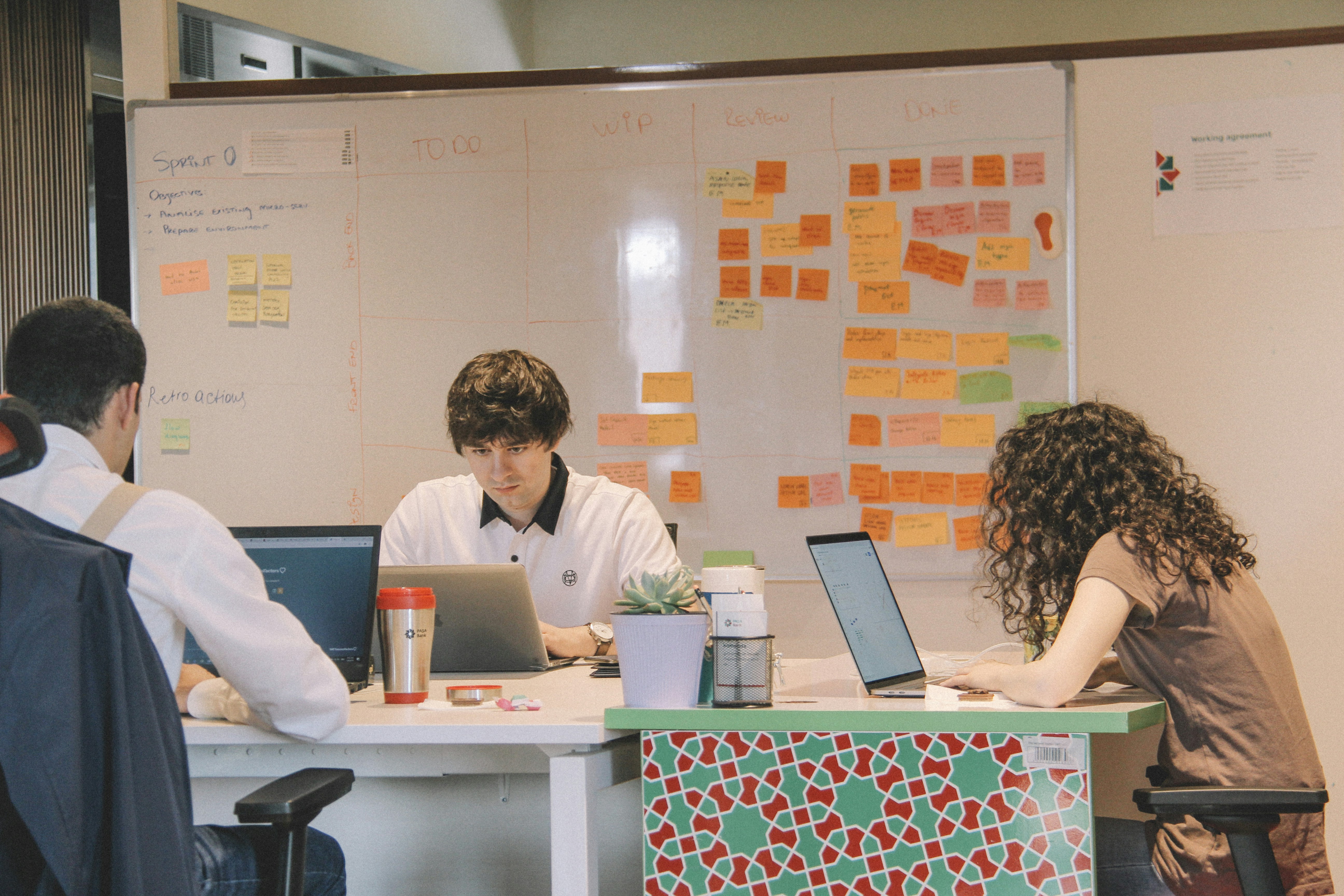Agile vs. Waterfall for Your Next Project: Choosing the Right Approach
Jan 1, 2024
Agile vs. Waterfall for Your Next Project: Choosing the Right Approach
Jan 1, 2024
Agile vs. Waterfall for Your Next Project: Choosing the Right Approach
Jan 1, 2024



In the realm of project management, two methodologies stand out as dominant contenders: Agile and Waterfall. Each approach offers distinct advantages and challenges, making the choice between them a critical decision for any project. In this blog post, we'll explore the differences between Agile and Waterfall methodologies and help you determine which one is the right fit for your next project.
Understanding Agile and Waterfall Methodologies
Waterfall Methodology:
The Waterfall methodology follows a sequential, linear approach to project management. It consists of distinct phases, including requirements gathering, design, implementation, testing, deployment, and maintenance. Each phase must be completed before moving on to the next, with little room for iteration or flexibility.
Agile Methodology:
In contrast, Agile methodology is characterized by flexibility, collaboration, and iterative development. It emphasizes delivering working software in small, incremental releases, with frequent feedback and adaptation throughout the project lifecycle. Agile teams work in short, time-boxed iterations called sprints, continuously refining and prioritizing features based on stakeholder feedback.
Key Considerations for Choosing Between Agile and Waterfall
Project Requirements Clarity:
Waterfall: Ideal for projects with well-defined requirements upfront. It's suitable when the scope, timeline, and budget are fixed, and there's little expectation of changes during development.
Agile: Suited for projects with evolving or unclear requirements. Agile allows for flexibility and accommodates changes throughout the project, making it ideal for complex or dynamic environments.
Flexibility and Adaptability:
Waterfall: Offers little flexibility once the project begins, as changes can be costly and time-consuming to implement.
Agile: Emphasizes adaptability and responsiveness to change. Agile teams can adjust priorities, features, and requirements based on evolving stakeholder needs and market dynamics.
Project Control and Visibility:
Waterfall: Provides clear milestones and deliverables, making it easier to track progress and manage expectations.
Agile: Offers less predictability in terms of timelines and deliverables, as priorities may shift during development. However, Agile provides greater transparency and collaboration, with regular updates and opportunities for stakeholder involvement.
Risk Management:
Waterfall: Risks are typically addressed upfront during the planning phase, with less opportunity for course correction as the project progresses.
Agile: Embraces uncertainty and mitigates risks through iterative development and frequent feedback loops. Agile teams can identify and address issues early, minimizing the impact of potential risks on project outcomes.
Choosing the Right Approach for Your Project
When deciding between Agile and Waterfall methodologies for your next project, consider the following factors:
Project Complexity: Agile is well-suited for projects with evolving requirements or high levels of uncertainty, while Waterfall may be more appropriate for straightforward, well-defined projects.
Stakeholder Involvement: Agile encourages frequent collaboration and feedback from stakeholders throughout the project, whereas Waterfall may involve less stakeholder engagement until later stages.
Team Experience and Expertise: Consider the experience and expertise of your project team. Agile requires a certain level of maturity and collaboration, whereas Waterfall may be more familiar to teams accustomed to traditional project management approaches.
Timeline and Budget Constraints: Evaluate your project's timeline and budget constraints. Agile allows for more flexibility in adapting to changes, whereas Waterfall requires careful planning and adherence to deadlines.
Conclusion
Both Agile and Waterfall methodologies offer distinct benefits and challenges, making them suitable for different types of projects and organizational contexts. When choosing between Agile and Waterfall for your next project, consider factors such as project requirements, flexibility, stakeholder involvement, team experience, and budget constraints. By selecting the right approach that aligns with your project goals and constraints, you can set your project up for success and achieve optimal outcomes.
In the realm of project management, two methodologies stand out as dominant contenders: Agile and Waterfall. Each approach offers distinct advantages and challenges, making the choice between them a critical decision for any project. In this blog post, we'll explore the differences between Agile and Waterfall methodologies and help you determine which one is the right fit for your next project.
Understanding Agile and Waterfall Methodologies
Waterfall Methodology:
The Waterfall methodology follows a sequential, linear approach to project management. It consists of distinct phases, including requirements gathering, design, implementation, testing, deployment, and maintenance. Each phase must be completed before moving on to the next, with little room for iteration or flexibility.
Agile Methodology:
In contrast, Agile methodology is characterized by flexibility, collaboration, and iterative development. It emphasizes delivering working software in small, incremental releases, with frequent feedback and adaptation throughout the project lifecycle. Agile teams work in short, time-boxed iterations called sprints, continuously refining and prioritizing features based on stakeholder feedback.
Key Considerations for Choosing Between Agile and Waterfall
Project Requirements Clarity:
Waterfall: Ideal for projects with well-defined requirements upfront. It's suitable when the scope, timeline, and budget are fixed, and there's little expectation of changes during development.
Agile: Suited for projects with evolving or unclear requirements. Agile allows for flexibility and accommodates changes throughout the project, making it ideal for complex or dynamic environments.
Flexibility and Adaptability:
Waterfall: Offers little flexibility once the project begins, as changes can be costly and time-consuming to implement.
Agile: Emphasizes adaptability and responsiveness to change. Agile teams can adjust priorities, features, and requirements based on evolving stakeholder needs and market dynamics.
Project Control and Visibility:
Waterfall: Provides clear milestones and deliverables, making it easier to track progress and manage expectations.
Agile: Offers less predictability in terms of timelines and deliverables, as priorities may shift during development. However, Agile provides greater transparency and collaboration, with regular updates and opportunities for stakeholder involvement.
Risk Management:
Waterfall: Risks are typically addressed upfront during the planning phase, with less opportunity for course correction as the project progresses.
Agile: Embraces uncertainty and mitigates risks through iterative development and frequent feedback loops. Agile teams can identify and address issues early, minimizing the impact of potential risks on project outcomes.
Choosing the Right Approach for Your Project
When deciding between Agile and Waterfall methodologies for your next project, consider the following factors:
Project Complexity: Agile is well-suited for projects with evolving requirements or high levels of uncertainty, while Waterfall may be more appropriate for straightforward, well-defined projects.
Stakeholder Involvement: Agile encourages frequent collaboration and feedback from stakeholders throughout the project, whereas Waterfall may involve less stakeholder engagement until later stages.
Team Experience and Expertise: Consider the experience and expertise of your project team. Agile requires a certain level of maturity and collaboration, whereas Waterfall may be more familiar to teams accustomed to traditional project management approaches.
Timeline and Budget Constraints: Evaluate your project's timeline and budget constraints. Agile allows for more flexibility in adapting to changes, whereas Waterfall requires careful planning and adherence to deadlines.
Conclusion
Both Agile and Waterfall methodologies offer distinct benefits and challenges, making them suitable for different types of projects and organizational contexts. When choosing between Agile and Waterfall for your next project, consider factors such as project requirements, flexibility, stakeholder involvement, team experience, and budget constraints. By selecting the right approach that aligns with your project goals and constraints, you can set your project up for success and achieve optimal outcomes.
In the realm of project management, two methodologies stand out as dominant contenders: Agile and Waterfall. Each approach offers distinct advantages and challenges, making the choice between them a critical decision for any project. In this blog post, we'll explore the differences between Agile and Waterfall methodologies and help you determine which one is the right fit for your next project.
Understanding Agile and Waterfall Methodologies
Waterfall Methodology:
The Waterfall methodology follows a sequential, linear approach to project management. It consists of distinct phases, including requirements gathering, design, implementation, testing, deployment, and maintenance. Each phase must be completed before moving on to the next, with little room for iteration or flexibility.
Agile Methodology:
In contrast, Agile methodology is characterized by flexibility, collaboration, and iterative development. It emphasizes delivering working software in small, incremental releases, with frequent feedback and adaptation throughout the project lifecycle. Agile teams work in short, time-boxed iterations called sprints, continuously refining and prioritizing features based on stakeholder feedback.
Key Considerations for Choosing Between Agile and Waterfall
Project Requirements Clarity:
Waterfall: Ideal for projects with well-defined requirements upfront. It's suitable when the scope, timeline, and budget are fixed, and there's little expectation of changes during development.
Agile: Suited for projects with evolving or unclear requirements. Agile allows for flexibility and accommodates changes throughout the project, making it ideal for complex or dynamic environments.
Flexibility and Adaptability:
Waterfall: Offers little flexibility once the project begins, as changes can be costly and time-consuming to implement.
Agile: Emphasizes adaptability and responsiveness to change. Agile teams can adjust priorities, features, and requirements based on evolving stakeholder needs and market dynamics.
Project Control and Visibility:
Waterfall: Provides clear milestones and deliverables, making it easier to track progress and manage expectations.
Agile: Offers less predictability in terms of timelines and deliverables, as priorities may shift during development. However, Agile provides greater transparency and collaboration, with regular updates and opportunities for stakeholder involvement.
Risk Management:
Waterfall: Risks are typically addressed upfront during the planning phase, with less opportunity for course correction as the project progresses.
Agile: Embraces uncertainty and mitigates risks through iterative development and frequent feedback loops. Agile teams can identify and address issues early, minimizing the impact of potential risks on project outcomes.
Choosing the Right Approach for Your Project
When deciding between Agile and Waterfall methodologies for your next project, consider the following factors:
Project Complexity: Agile is well-suited for projects with evolving requirements or high levels of uncertainty, while Waterfall may be more appropriate for straightforward, well-defined projects.
Stakeholder Involvement: Agile encourages frequent collaboration and feedback from stakeholders throughout the project, whereas Waterfall may involve less stakeholder engagement until later stages.
Team Experience and Expertise: Consider the experience and expertise of your project team. Agile requires a certain level of maturity and collaboration, whereas Waterfall may be more familiar to teams accustomed to traditional project management approaches.
Timeline and Budget Constraints: Evaluate your project's timeline and budget constraints. Agile allows for more flexibility in adapting to changes, whereas Waterfall requires careful planning and adherence to deadlines.
Conclusion
Both Agile and Waterfall methodologies offer distinct benefits and challenges, making them suitable for different types of projects and organizational contexts. When choosing between Agile and Waterfall for your next project, consider factors such as project requirements, flexibility, stakeholder involvement, team experience, and budget constraints. By selecting the right approach that aligns with your project goals and constraints, you can set your project up for success and achieve optimal outcomes.


